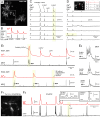Plateau depolarizations in spontaneously active neurons detected by calcium or voltage imaging
- PMID: 39367010
- PMCID: PMC11452489
- DOI: 10.1038/s41598-024-70319-4
Plateau depolarizations in spontaneously active neurons detected by calcium or voltage imaging
Abstract
In calcium imaging studies, Ca2+ transients are commonly interpreted as neuronal action potentials (APs). However, our findings demonstrate that robust optical Ca2+ transients primarily stem from complex "AP-Plateaus", while simple APs lacking underlying depolarization envelopes produce much weaker photonic signatures. Under challenging in vivo conditions, these "AP-Plateaus" are likely to surpass noise levels, thus dominating the Ca2+ recordings. In spontaneously active neuronal culture, optical Ca2+ transients (OGB1-AM, GCaMP6f) exhibited approximately tenfold greater amplitude and twofold longer half-width compared to optical voltage transients (ArcLightD). The amplitude of the ArcLightD signal exhibited a strong correlation with the duration of the underlying membrane depolarization, and a weaker correlation with the presence of a fast sodium AP. Specifically, ArcLightD exhibited robust responsiveness to the slow "foot" but not the fast "trunk" of the neuronal AP. Particularly potent stimulators of optical signals in both Ca2+ and voltage imaging modalities were APs combined with plateau potentials (AP-Plateaus), resembling dendritic Ca2+ spikes or "UP states" in pyramidal neurons. Interestingly, even the spikeless plateaus (amplitude > 10 mV, duration > 200 ms) could generate conspicuous Ca2+ optical signals in neurons. Therefore, in certain circumstances, Ca2+ transients should not be interpreted solely as indicators of neuronal AP firing.
© 2024. The Author(s).
Conflict of interest statement
The authors declare no competing interests.
Figures





Similar articles
-
Layer I neurons of rat neocortex. I. Action potential and repetitive firing properties.J Neurophysiol. 1996 Aug;76(2):651-67. doi: 10.1152/jn.1996.76.2.651. J Neurophysiol. 1996. PMID: 8871189
-
Voltage-gated potassium channels activated during action potentials in layer V neocortical pyramidal neurons.J Neurophysiol. 2000 Jan;83(1):70-80. doi: 10.1152/jn.2000.83.1.70. J Neurophysiol. 2000. PMID: 10634854
-
Back-propagating action potentials mediate calcium signalling in dendrites of bitufted interneurons in layer 2/3 of rat somatosensory cortex.J Physiol. 2001 Aug 15;535(Pt 1):17-31. doi: 10.1111/j.1469-7793.2001.t01-1-00017.x. J Physiol. 2001. PMID: 11507155 Free PMC article.
-
Dendritic Ca2+ transients evoked by action potentials in rat dorsal cochlear nucleus pyramidal and cartwheel neurons.J Neurophysiol. 2003 Apr;89(4):2225-37. doi: 10.1152/jn.00709.2002. Epub 2002 Dec 4. J Neurophysiol. 2003. PMID: 12612001
-
Reporting neural activity with genetically encoded calcium indicators.Brain Cell Biol. 2008 Aug;36(1-4):69-86. doi: 10.1007/s11068-008-9029-4. Epub 2008 Oct 22. Brain Cell Biol. 2008. PMID: 18941901 Free PMC article. Review.
Cited by
-
Spike rate inference from mouse spinal cord calcium imaging data.bioRxiv [Preprint]. 2025 Jan 11:2024.07.17.603957. doi: 10.1101/2024.07.17.603957. bioRxiv. 2025. Update in: J Neurosci. 2025 Mar 24:e1187242025. doi: 10.1523/JNEUROSCI.1187-24.2025. PMID: 39829770 Free PMC article. Updated. Preprint.
-
Spike rate inference from mouse spinal cord calcium imaging data.J Neurosci. 2025 Mar 24;45(18):e1187242025. doi: 10.1523/JNEUROSCI.1187-24.2025. Online ahead of print. J Neurosci. 2025. PMID: 40127941 Free PMC article.
References
-
- Cohen, E., Ivenshitz, M., Amor-Baroukh, V., Greenberger, V. & Segal, M. Determinants of spontaneous activity in networks of cultured hippocampus. Brain Res.1235, 21–30 (2008). - PubMed
-
- Larkum, M. E., Nevian, T., Sandler, M., Polsky, A. & Schiller, J. Synaptic integration in tuft dendrites of layer 5 pyramidal neurons: A new unifying principle. Science325(5941), 756–760 (2009). - PubMed
MeSH terms
Substances
Grants and funding
LinkOut - more resources
Full Text Sources
Miscellaneous

